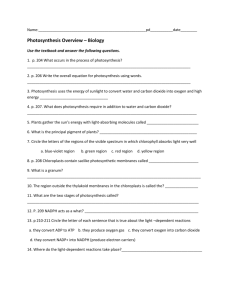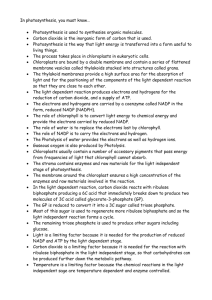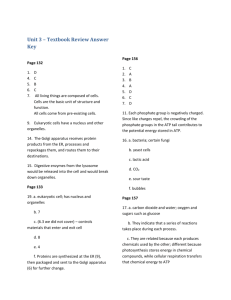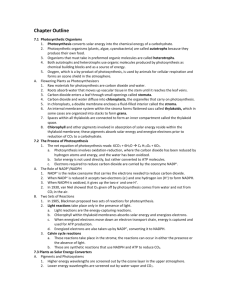Mader/Biology, 11/e – Chapter Outline
advertisement
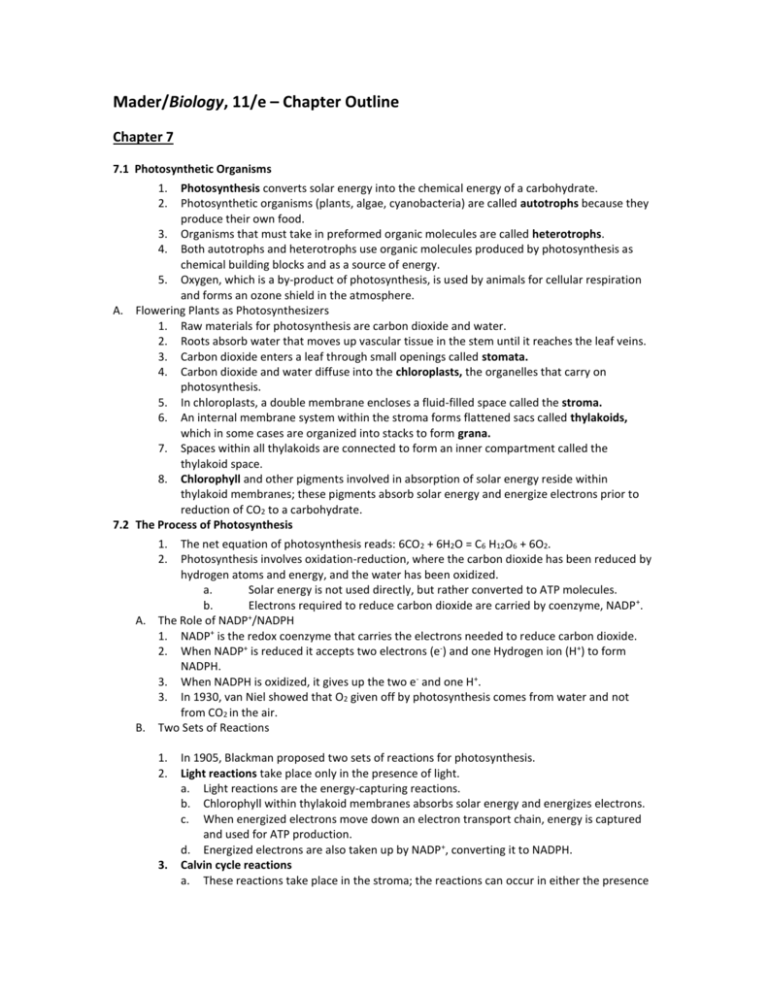
Mader/Biology, 11/e – Chapter Outline Chapter 7 7.1 Photosynthetic Organisms 1. 2. Photosynthesis converts solar energy into the chemical energy of a carbohydrate. Photosynthetic organisms (plants, algae, cyanobacteria) are called autotrophs because they produce their own food. 3. Organisms that must take in preformed organic molecules are called heterotrophs. 4. Both autotrophs and heterotrophs use organic molecules produced by photosynthesis as chemical building blocks and as a source of energy. 5. Oxygen, which is a by-product of photosynthesis, is used by animals for cellular respiration and forms an ozone shield in the atmosphere. A. Flowering Plants as Photosynthesizers 1. Raw materials for photosynthesis are carbon dioxide and water. 2. Roots absorb water that moves up vascular tissue in the stem until it reaches the leaf veins. 3. Carbon dioxide enters a leaf through small openings called stomata. 4. Carbon dioxide and water diffuse into the chloroplasts, the organelles that carry on photosynthesis. 5. In chloroplasts, a double membrane encloses a fluid-filled space called the stroma. 6. An internal membrane system within the stroma forms flattened sacs called thylakoids, which in some cases are organized into stacks to form grana. 7. Spaces within all thylakoids are connected to form an inner compartment called the thylakoid space. 8. Chlorophyll and other pigments involved in absorption of solar energy reside within thylakoid membranes; these pigments absorb solar energy and energize electrons prior to reduction of CO2 to a carbohydrate. 7.2 The Process of Photosynthesis 1. 2. The net equation of photosynthesis reads: 6CO 2 + 6H2O = C6 H12O6 + 6O2. Photosynthesis involves oxidation-reduction, where the carbon dioxide has been reduced by hydrogen atoms and energy, and the water has been oxidized. a. Solar energy is not used directly, but rather converted to ATP molecules. b. Electrons required to reduce carbon dioxide are carried by coenzyme, NADP +. + A. The Role of NADP /NADPH 1. NADP+ is the redox coenzyme that carries the electrons needed to reduce carbon dioxide. 2. When NADP+ is reduced it accepts two electrons (e-) and one Hydrogen ion (H+) to form NADPH. 3. When NADPH is oxidized, it gives up the two e- and one H+. 3. In 1930, van Niel showed that O2 given off by photosynthesis comes from water and not from CO2 in the air. B. Two Sets of Reactions 1. 2. 3. In 1905, Blackman proposed two sets of reactions for photosynthesis. Light reactions take place only in the presence of light. a. Light reactions are the energy-capturing reactions. b. Chlorophyll within thylakoid membranes absorbs solar energy and energizes electrons. c. When energized electrons move down an electron transport chain, energy is captured and used for ATP production. d. Energized electrons are also taken up by NADP+, converting it to NADPH. Calvin cycle reactions a. These reactions take place in the stroma; the reactions can occur in either the presence b. or the absence of light. These are synthetic reactions that use NADPH and ATP to reduce CO 2. 7.3 Plants as Solar Energy Converters B. A. Pigments and Photosystems 1. Higher energy wavelengths are screened out by the ozone layer in the upper atmosphere. 2. Lower energy wavelengths are screened out by water vapor and CO 2. 3. Both the organic molecules within organisms and certain processes (e.g., vision, photosynthesis) are adapted to visible light, the radiation that is most prevalent in the environment. 4. Photosynthetic pigments use primarily the visible light portion of the electromagnetic spectrum. 5. Pigments found in chlorophyll absorb various portions of visible light; this is called their absorption spectrum. 6. Two major photosynthetic pigments are chlorophyll a and chlorophyll b. 7. Both chlorophylls absorb violet, blue, and red wavelengths best. 8. Very little green light is absorbed; most is reflected (this is why leaves appear green). 9. Carotenoids are yellow-orange pigments that absorb light in violet, blue, and green regions. 10. When chlorophyll breaks down in the fall, the yellow-orange pigments in leaves show through. 11. Absorption and action spectrum a. A spectrophotometer measures the amount of light that passes through a sample. b. As light is shone on a sample, some wavelengths are absorbed and others pass through the sample. c. A graph of percent of light absorbed at each wavelength is a compound’s absorption spectrum. 12. A photosystem is a photosynthetic unit comprised of a pigment complex and an electron acceptor; solar energy is absorbed and high-energy electrons are generated. The Electron Flow in the Light Reactions 1. 2. 3. 4. 5. 6. 7. 8. 9. 10. 11. 12. 13. This light reaction requires participation of two light-gathering units: photosystem I (PS I) and photosystem II (PS II). The noncyclic pathway begins with PSII; electrons move from H 2O through PS II to PS I and then on to NADP+. The PS II pigment complex absorbs solar energy; high-energy electrons (e-) leave the reaction-center chlorophyll a molecule. PS II takes replacement electrons from H2O, which splits, releasing O2 and H+ ions: H2O = 2 H+ + 2 e- + ½ O2. Oxygen is released as oxygen gas (O2). The H+ ions temporarily stay within the thylakoid space and contribute to a H+ ion gradient. As H+ flow down electrochemical gradient through ATP synthase complexes, chemiosmosis occurs. Low-energy electrons leaving the electron transport system enter PS I. When the PS I pigment complex absorbs solar energy, high-energy electrons leave reaction-center chlorophyll a and are captured by an electron acceptor. The electron acceptor passes them on to NADP+. NADP+ takes on an H+ to become NADPH: NADP+ + 2 e- + H+ = NADPH. NADPH and ATP (produced by noncyclic-flow electrons in the thylakoid membrane) are used by enzymes in the stroma during the light-independent reactions. Some electrons follow a cyclical path. They are rerouted to an earlier point in the electron transport chain and participates in more redox reactions. C. The Organization of the Thylakoid Membrane 1. PS II consists of a pigment complex and electron-acceptor molecules; it oxidizes H2O and produces O2. 2. The electron transport system consists of cytochrome complexes and transports electrons and pumps H+ ions into the thylakoid space. 3. PS I has a pigment complex and electron-acceptor molecules; it is associated with an enzyme that reduces NADP+ to NADPH. 4. ATP synthase complex has an H+ channel and ATP synthase; it produces ATP. D. ATP Production 1. The thylakoid space acts as a reservoir for H+ ions; each time H2O is split, two H+ remain. 2. Electrons move carrier-to-carrier, giving up energy used to pump H+ from the stroma into the thylakoid space. 3. Flow of H+ from high to low concentration across thylakoid membrane provides energy to produce ATP from ADP + P by using an ATP synthase complex enzyme. 4. This is called chemiosmosis because ATP production is tied to an electrochemical (H+) gradient. E. Tropical Rain Forest Destruction and Global Warming (Biological Systems reading) 1. Climate change is an unexpected rise in the average global temperature during the 21 st century due to the introduction of certain gases into the atmosphere. 2. For more than 1,000 years before 1850, carbon dioxide levels remained fairly constant at 0.028%. 3. Following the 1850s (marked by the industrial revolution), the amount of carbon dioxide in the atmosphere increased to 0.038%. 4. Role of Carbon Dioxide a. Carbon dioxide, as well as other gases, traps radiant heat from the sun. b. Factors adding carbon dioxide to the atmosphere include: burning of fossil fuels, and destructing tropical rain forests. 5. Role of Tropical Rain Forests a. Ten – 30 million hectares of rain forests are lost every year due to ranching, logging, and mining. b. Each year, tropical rain forest deforestation accounts for 20–30% of all carbon dioxide in the atmosphere. c. Destruction of tropical rain forests is also troublesome because burning a forest adds carbon dioxide to the atmosphere, and also removes trees that normally would absorb carbon dioxide. 6. The Earth Is a System a. Tropical rain forests contribute to the uptake of carbon dioxide, and the productivity of photosynthesis. b. Tropical rain forests exist between the Tropic of Cancer and Tropic of Capricorn, temperatures are about 26 C, and rainfall is 100-200 cm and regular. c. Tropical rain forest tree characteristics include: large trees, buttressed trunks, broad, simple dark-green leaves, and vines (lianas). d. Researchers suggest that as temperatures rise, tropical rain forests may add to atmospheric carbon dioxide accumulation and accelerate global warming rather than the reverse. e. To combat deforestation, some countries, such as Costa Rica, have developed national park systems and reserves to protect the forests from destruction. 7.4 Plants as Carbon Dioxide Fixers 1. 2. The Calvin cycle is a series of reactions producing carbohydrates; these reactions follow the light reactions. The cycle is named for Melvin Calvin who used a radioactive isotope of carbon to trace the reactions. 3. A. B. C. D. 7.5 A. B. The Calvin cycle includes carbon dioxide fixation, carbon dioxide reduction, and regeneration of ribulose 1,5-bisphosphate (RuBP). Fixation of Carbon Dioxide 1. CO2 fixation is the attachment of CO2 to an organic compound called RuBP. 2. RuBP (ribulose bisphosphate) is a five-carbon molecule that combines with carbon dioxide; the resulting 6-carbon molecule then splits into two 3-carbon molecules. 3. The enzyme RuBP carboxylase (rubisco) speeds this reaction; this enzyme comprises 20– 50% of the protein content of chloroplasts—it is an unusually slow enzyme. Reduction of Carbon Dioxide 1. With the reduction of carbon dioxide, a 3PG (3-phosphoglycerate) molecule forms. 2. Each of two 3PG molecules undergoes reduction to G3P (glyceraldehyde-3-phosphate) in two steps. 3. Light-dependent reactions provide NADPH (electrons) and ATP (energy) to reduce 3PG to G3P. Regeneration of RuBP 1. For every three turns of the Calvin cycle, five molecules of G3P are used to re-form three molecules of RuBP. 2. This reaction also uses ATP produced by the light reactions. The Importance of the Calvin Cycle 1. G3P, the product of the Calvin Cycle can be converted into many other molecules. 2. Glucose phosphate is one result of G3P metabolism; it is a common energy molecule. 3. Glucose phosphate can bond with fructose to form sucrose. 4. Glucose phosphate is the starting point for synthesis of starch and cellulose. 5. The hydrocarbon skeleton of G3P is used to form fatty acids and glycerol; the addition of nitrogen forms various amino acids. Other Types of Photosynthesis 1. In C3 plants, the Calvin cycle fixes CO2 directly; the first molecule following CO2 fixation is 3PG. 2. In hot weather, stomata close to save water; CO2 concentration decreases in leaves; O2 increases. 3. This is called photorespiration since oxygen is taken up and CO2 is produced; this produces only one 3PG. C4 Photosynthesis 1. In a C3 plant, mesophyll cells contain well-formed chloroplasts, arranged in parallel layers. 2. In C4 plants, bundle sheath cells as well as the mesophyll cells contain chloroplasts. 3. In C4 leaf, mesophyll cells are arranged concentrically around the bundle sheath cells. 4. C3 plants use RuBP carboxylase to fix CO2 to RuBP in mesophyll; the first detected molecule is G3P. 5. C4 plants use the enzyme PEP carboxylase (PEPCase) to fix CO2 to PEP (phosphoenolpyruvate, a C3 molecule); the end product is oxaloacetate (a C4 molecule). 6. In C4 plants, CO2 is taken up in mesophyll cells and malate, a reduced form of oxaloacetate, is pumped into the bundle-sheath cells; here CO2 enters Calvin cycle. 7. In hot, dry climates, net photosynthetic rate of C 4 plants (e.g., corn) is 2–3 times that of C4 plants. 8. Photorespiration does not occur in C4 leaves because PEPCase does not combine with O2; even when stomates are closed, CO2 is delivered to the Calvin cycle in bundle sheath cells. 9. C4 plants have advantage over C3 plants in hot and dry weather because photorespiration does not occur; e.g., bluegrass (C3) dominates lawns in early summer, whereas crabgrass (C4) takes over in the hot midsummer. CAM Photosynthesis 1. CAM (crassulacean-acid metabolism) plants form a C4 molecule at night when stomates can open without loss of water; found in many succulent desert plants including the family Crassulaceae. 2. C. At night, CAM plants use PEPCase to fix CO2 by forming C4 molecule stored in large vacuoles in mesophyll. 3. C4 formed at night is broken down to CO2 during the day and enters the Calvin cycle within the same cell, which now has NADPH and ATP available to it from the light-dependent reactions. 4. CAM plants open stomates only at night, allowing CO2 to enter photosynthesizing tissues; during the day, stomates are closed to conserve water but CO2 cannot enter photosynthesizing tissues. 5. Photosynthesis in a CAM plant is minimal, due to limited amount of CO 2 fixed at night; but this does allow CAM plants to live under stressful conditions. Photosynthesis and Adaptation to the Environment 1. 2. Each method of photosynthesis has its advantages, depending on the environment. C4 plants are adapted to areas of high light intensities, high temperatures, and limited rainfall. 3. C3 plants do better in cooler climates. CAM plants do well in an arid environment.


